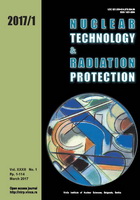
UNCERTAINTIES IN MEASURING TRACE AMOUNTS OF COBALT AND EUROPIUM WITH LOW-FLUX NEUTRON ACTIVATION ANALYSIS
Pages: 18-24
Authors: Steven Burnham, Greg Moffitt, Quentin Faure, and Tatjana JevremovicAbstract
Neutron activation analysis is widely used for identification of elements and their quantities even in trace amounts in the samples of almost any type. The challenges in detecting trace amounts of particular elements are often associated with the neutron flux produced at the research reactors. Low-flux neutron activation analysis usually presents the biggest challenge when analyzing trace quantities of elements with lower magnitude of radiative capture cross-sections.
In this paper, we present the methodology and the quantified uncertainties associated with the detection of trace amounts of cobalt and europium, using as an example concrete aggregates. Recent growing interest is in improving structural concrete (increasing its strength but reducing its activation in nuclear power plant environments). Aside from buildings, structural concrete is also used as a biological shield in nuclear power plant that become radioactive after exposure to neutron flux. Due to radiative capture interactions, artificial radionuclides are generated to high enough concentrations that classify concrete as low-level radioactive waste at the time of the plant's decommissioning. Disposal of this concrete adds to the expense of nuclear power plant financing and its construction. Three radionuclides, 60Co, 152Eu, and 154Eu, account for 99 % of total residual radioactivity of nuclear power plant decommissioned concrete. IAEA document RS-G-1.7, Application of the Concepts of Exclusion, Exemption, and Clearance, specifies clearance levels of radionuclides specific activities: a specific activity lower than 0.1 Bqg-1 for 60Co and
152Eu, and 154Eu allows for a concrete to be recycled after decommissioning of the nuclear power plant. Therefore, low-flux neutron activation analysis is used to test the detection limits of trace elements in samples of cement, coarse, and fine concrete aggregates. These samples are irradiated at the University of Utah's 100 kW TRIGA Reactor at power levels of 10 kW, 30 kW, and 90 kW, with the corresponding thermal neutron flux values of 1.5×108, 7.3×109, and 3.76×1011 cm-2s-1.The samples are irradiated for time periods of 1, 3, 30, 60, and 120 minutes. Different power levels and different irradiation times are used to find if there is a threshold set of neutron activation analysis parameters in detecting trace amounts of these isotopes. Each of the samples is counted on a Canberra BEGe high purity germanium detector. Cement samples are concurrently irradiated with a National Institute of Standards and Technology coal fly ash standard reference material and coarse and fine aggregates with Montana soil standard reference material to accurately quantify the mass concentration of the isotopes in concrete samples. Final results show that reactor power, irradiation, and detector measurement times are heavily correlated to finding the optimum combination for a low-flux neutron activation analysis approach in detecting trace contents of elements, specifically cobalt and europium.
Key words: gamma detection, neutron activation analysis, concrete, research reactor, nuclear power plant decommissioning, cobalt, europium
FULL PAPER IN PDF FORMAT (469 KB)
